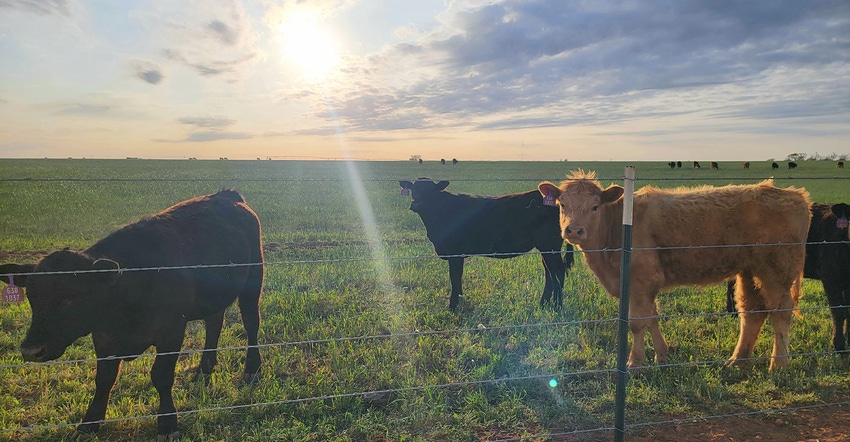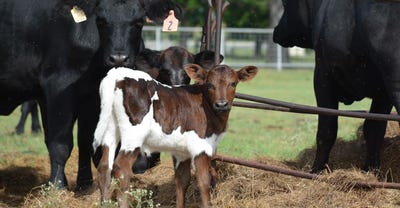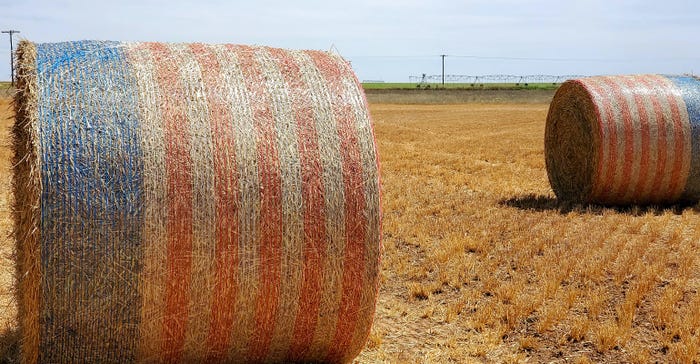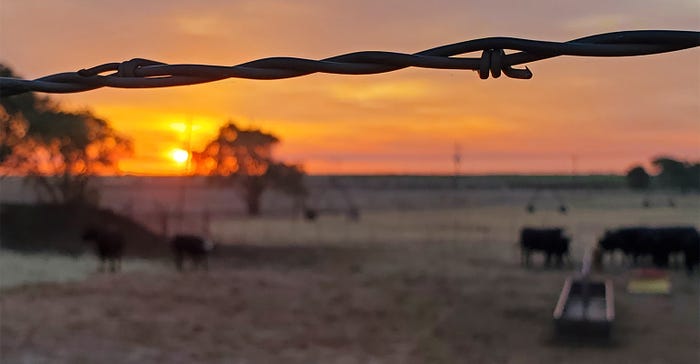
Beef cattle prices and forage conditions have been much improved for Texas producers so far in 2021, according to Texas A&M AgriLife Extension Service experts.
Most Texas cattle producers experienced cooler, wetter summer conditions than normal, but weather has turned drier over the past few weeks as they prepare for fall and winter. Prices on most cattle classes have also been higher over the course of 2021 than in previous years.
 (Photo by Shelley E. Huguley)
(Photo by Shelley E. Huguley)
Joe Paschal, AgriLife Extension livestock specialist, Corpus Christi, and Jason Smith, AgriLife Extension beef cattle specialist, Amarillo, both in the Department of Animal Science within the Texas A&M College of Agriculture and Life Sciences, said growing conditions were very similar in their respective regions, but that producers should be planning for a drier winter after weather took a turn for the better this summer.
Cattle, forage conditions in South, Southwest
Early dry conditions turned extremely wet as the Upper Coast entered summer while rains came later and lighter to South and Southwest Texas, Paschal said.
Paschal said negatives associated with heavy rains in the Upper Coastal region included flooding in low areas and muddy conditions for ranchers and their herds. There were also higher numbers of flies and mosquitoes and likely an increase in internal and external parasites due to above-normal moisture levels.
There were also some fatal cases of pneumonia in calves and younger cattle due to high humidity and continual rains, he said.
Forage quantities increased but quality decreased due to weeds, he said. Pastures may have recovered some for ranchers who avoided overgrazing but not enough for fall due to the lack of moisture over the last several weeks.
 “It was a bumper crop of hay for two cuttings, but most of it is probably low quality and should be tested so that ranchers can plan a good supplementation program,” Paschal said. “Most cows recovered body condition, but some have not, and good feed programs are important for the next crop of calves.”
“It was a bumper crop of hay for two cuttings, but most of it is probably low quality and should be tested so that ranchers can plan a good supplementation program,” Paschal said. “Most cows recovered body condition, but some have not, and good feed programs are important for the next crop of calves.”
(Photo by Shelley E. Huguley)
Conditions were drier in South and Southwest Texas areas, but most pastures and rangelands were understocked due to drought, so grasses recovered quicker, he said. Those areas did not produce as much hay, but cuttings were generally very good quality and quantity.
There were fewer cattle in poor body condition in those areas, Paschal said.
“The rains are long gone, and the grass is dry to crispy dry,” he said. “Nights are cooler, so I doubt there will be any additional summer grass growth even if it did rain, but we could use the moisture to replenish tank water for livestock and wildlife and for any winter pasture that is planted.”
Cattle, forage conditions across the Texas Plains, Panhandle
To the north, overall cattle and grazing conditions were relatively good, Smith said.
Forage grasses were slow-growing for the most part as conditions turned drier, but grazing is good. The question is for how long.
Much of the Panhandle and Texas Plains received some much-needed rainfall this summer and experienced tolerable temperatures, he said. The weather is cooling down, but like most of the state, conditions have once again turned dry.
 (Photo by Shelley E. Huguley)
(Photo by Shelley E. Huguley)
Smith said despite pasture and rangeland conditions being better than last September, stocking rates should reflect their available forage and hay stores with the expectation for drier conditions. Rain is in the forecast, which could help winter wheat pastures establish, but producers should avoid overgrazing.
Drought in the past has conditioned most experienced ranchers to plan for short moisture, but Smith said that there is always a temptation to add cattle when forages are plentiful. Making value-based supplemental feeding decisions is important this year due to high feed costs.
“I always encourage producers to be mindful and plan for the worst,” he said. “It’s easier to react to an overabundance of forages than it is to respond to a shortage. It has not been cheap to feed cattle anything over the past year, so producers need to be mindful of their input costs and adjust according to their situation.”
Available surface water is hit and miss around the Panhandle and Texas Plains, Smith said. Most creeks are dry, and some playa lakes that typically hold water are as well, while others have been replenished by scattered rainfall.
Better cattle market conditions
Justin Benavidez, AgriLife Extension economist, Amarillo, said price outlooks were favorable for producers. Prices on most classifications were higher and were expected to stay relatively strong at this point in the cattle cycle.
 (Photo by Shelley E. Huguley)
(Photo by Shelley E. Huguley)
The overall U.S. herd is shrinking due to severe drought in western and northwestern states, but not as significantly as in 2011, when Texas producers were forced to thin herds and liquidate, he said. But the overall herd reduction will ripple into the market for at least the next two calving cycles.
“Every cull cow removed from the herd is not going to produce a calf during the upcoming year,” he said. “So, we have lost a year’s worth of new slaughter and breeding cattle due to liquidation in states dealing with severe drought. That will likely affect prices into next year and possibly beyond.”
AgriLife Extension district reporters compiled the following summaries:

CENTRAL
Topsoil was powdery dry, but forecasts called for wetter conditions over the next month. Temperatures were cooler with nighttime lows in the 50s. Producers were dry planting oats in expectation of rainfall, but no wheat was planted so far. Rains would help winter forage crops establish. There were concerns about fall armyworms eating newly planted cool-season forages. Cotton harvest was underway, and good yields were reported. Cotton acres were lower than previous years, which should make for a quick harvest. Hay operations slowed to a crawl. Cattle were in great condition, and many were expected to be marketed shortly.
ROLLING PLAINS
Some areas benefited over the past few weeks from rain, while others received none. There was a good chance of rain in the forecast. Temperatures were also cooler, but a few small grass fires occurred over the past week. Grasshoppers were in fields and pastures but were not causing much damage, and other pest activity was light due to good beneficial insect numbers. Pastures were browning and showing green spots in low-lying areas. Available forage was declining. Calves and cows were still looking good, but were not gaining at the rate they were before dry conditions set in. Moisture will be needed for wheat to germinate, and most producers were waiting for moisture before planting. Hayfields that were managed correctly were able to produce another cutting. Producers were unsure about hay quality but were happy about stocks going into fall and winter.
COASTAL BEND
The first cool front arrived but very little rain was reported, and most areas remained dry. Field activities continued. Some tillage began in preparation for winter pasture planting. Cotton harvest was moving along and was complete in most areas. There was a lot of cotton at the gin yards and more still to be picked up at the fields. Cotton yields were average. Ratoon crop rice was heading out. Some late-planted soybeans were dropping leaves. Rangeland and pasture conditions were still good, but the drier conditions negatively impacted grass quality. Hay baling tapered off due to lack of moisture, and growth slowed. Pecan orchard floors were being prepared for harvest. Livestock were in good condition, and calves continued to gain well. Livestock market prices were higher than normal.
EAST
Conditions were dry for most of the district, and many counties desperately needed rainfall. Subsoil and topsoil conditions were short. Stock ponds and creeks were drying up. Jasper County reported some rain along with cooler temperatures. Hay production was winding down with producers trying to get one last cutting. Pasture and rangeland conditions were fair. Livestock were in fair to good condition. Wild pig activity and damage increased.
SOUTH PLAINS
Weather conditions across the district continued to be very dry. Farmers were busy harvesting corn, hay grazer and sorghum. Dryland cotton bolls were opening due to dry conditions. Cotton producers turned off irrigation wells for the rest of the season. Cotton fields needed at least three more weeks of above freezing weather. Cattle were in good condition.
PANHANDLE
Soil moisture levels were short throughout the district. Pasture and rangeland conditions were fair. Corn was mature, and harvest should begin soon. Good corn yields were expected. Sorghum was maturing. Cotton conditions were fair to good, and bolls were opening in early planted fields. Warm, dry weather helped cotton progress. Winter wheat was being planted. Some early wheat plantings were emerging under irrigation. Peanuts were in good condition.
NORTH
Soil moisture remained very short to short for most counties, and topsoil moisture continued to decline. Pastures were suffering from lack of moisture and growth was stalled. The lack of moisture was also delaying winter pasture plantings. Morning temperatures were cooler with daytime highs in the 80s and low-90s. Soybeans were being harvested. Livestock were doing well.
FAR WEST
There were a few scattered thunderstorms across the higher elevation, but the lower areas remained dry. The district experienced the first cool front of the season with lows dropping into the mid-40s in the upper elevations. The daytime temperatures were still averaging the mid-90s. Cotton bolls were opening quickly in dryland and early planted cotton fields. Yields appeared to be variable, but overall, above average. Irrigated and later-planted cotton was still behind and needed more heat units to fully mature. Fields and pastures were drying out after a month with no rainfall. Pastures were barren, and farmland was extremely dry and needs moisture to get wheat fields started and growing. Pecans were maturing, and the earliest maturing varieties were beginning to split shucks. Rangeland conditions were good in most places and cow-calf operations continued their fall weaning and shipping season.
WEST CENTRAL
Another week without rain continued to dry out the soil profile. All areas needed rain, and stock tank water levels dropped. Moisture was needed by row crops and for producers to prepare for winter wheat plantings. Rangelands and pastures continued to suffer from heat and moisture stress. Cotton fields were in mostly fair condition. Grain sorghum harvest was almost completed. Some wheat producers continued to dry plant crops. Hay producers harvested final cuttings.
SOUTHEAST
Rice harvest was ending, but a small amount of organic rice was still left to harvest along with the ratoon crop. There were still second and/or third cuttings of hay left to be cut. Pastures remained dry and in need of rain, but rangeland and pasture ratings ranged from poor to excellent. Livestock were in fair condition. Armyworms continued to be a problem.
SOUTHWEST
Conditions were drier with cooler temperatures across the district. Scattered rainfall, between 0.5 to 2 inches, was reported in Kinney County. Pastures and rangelands continued to decline due to lack of moisture and were going dormant in some areas. Corn, sorghum and cotton harvests were complete or wrapping up. Guadalupe County reported above-average corn yields. Hay production remained strong with extended dry periods allowing time for cutting and baling. Producers were still in the process of planting small grains. Livestock conditions were good, and producers were providing supplemental feed. Cattle, sheep and goat markets were steady.
SOUTH
Conditions were improving in some areas with cooler temperatures and some rainfall while conditions in other areas continued to decline. Temperatures were still into the 90s in McMullen County. Zapata and Jim Wells counties reported 0.5-1.5 inches of rain, while Duval and Hidalgo counties reported trace amounts up to 2 inches. Producers continued to harvest forages. Cotton harvest was complete, just beginning and/or moving along rapidly across the district. Irrigation pivots were still watering peanuts in some areas but digging was underway in some fields. Fieldwork for strawberries picked up. Summer vegetable production was wrapping up, and fall vegetable plantings continued to progress. Pecan crops were below average in some areas, and above average in others. Producers paused brush management spraying due to dry conditions. Pasture and rangeland conditions continued to decline in drier areas, but conditions greatly improved in areas that received rainfall. Pastures with moisture continued to produce grass, but production was slowing. Field preparation for wheat and oats planting continued, and some producers were dry planting due to rain in the forecast. Supplemental feeding of livestock and wildlife continued and increased in some areas. Beef cattle producers were busy weaning and shipping calves. Cattle sale volumes remained steady to slightly above average, and there were reports of slightly lower prices on all classes. Cattle prices in Live Oak County remained steady, and producers in other areas reported better prices. Stock tanks were full in some areas and declining under drier conditions in other areas. Producers were plowing and shredding corn and sorghum fields. Sugarcane and citrus continued to receive irrigation. Some late-planted sorghum remained unharvested.
Source: is AgriLife TODAY, which is solely responsible for the information provided and is wholly owned by the source. Informa Business Media and all its subsidiaries are not responsible for any of the content contained in this information asset.
About the Author(s)
You May Also Like




